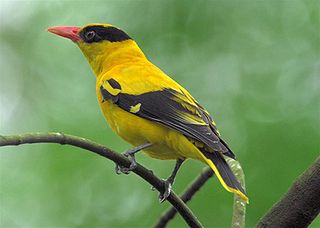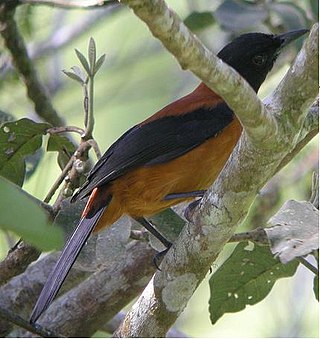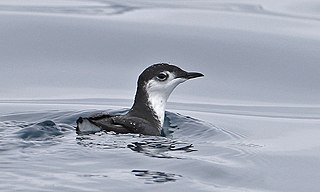
Orioles are colourful Old World passerine birds in the genus Oriolus, the type genus of the corvoidean family Oriolidae. They are not closely related to the New World orioles, which are icterids that belong to the superfamily Passeroidea.

The Old World orioles (Oriolidae) are an Old World family of passerine birds.

The figbirds are a genus (Sphecotheres) in the family of Old World orioles found in wooded habitats in Australia, New Guinea, and the Lesser Sundas.

The hooded pitohui is a species of bird in the genus Pitohui found in New Guinea. It was long thought to be a whistler (Pachycephalidae) but is now known to be in the Old World oriole family (Oriolidae). Within the oriole family, this species is most closely related to the variable pitohuis in the genus Pitohui, and then the figbirds.

The Guadalupe murrelet or Xantus's murrelet is a small seabird found in the California Current system in the Pacific Ocean. This auk breeds on islands off California and Mexico. It is threatened by predators introduced to its breeding colonies and by oil spills.

The Isabela oriole is a species of the oriole family endemic to Luzon in the Philippines. The bird was presumed to be extinct for many years until its rediscovery in December 1993 near Diffun, Quirino, and in Mansarong in September 1994. Additional sightings were made in San Mariano, Isabela. and Baggao, Cagayan Valley It It is found in moist lowland forest up to 440 masl. It is threatened by habitat loss and hunting.

The black-headed oriole is a species of bird in the family Oriolidae. It is found in Africa and has a very striking appearance with a bright yellow body, contrasting black head and flesh-coloured beak.
The green figbird or Timor figbird is a species of bird in the family Oriolidae. It is endemic to forest, woodland, mangrove, and scrub on the Indonesian islands of Roti and Timor. It is moderately common, so is considered to be of least concern by BirdLife International and the IUCN.
The Wetar ground dove is a species of bird in the family Columbidae found on Wetar, Indonesia, and on Timor. Its natural habitats are monsoon forests and gallery forests, and possibly woodland and bamboos. Threatened by habitat loss and hunting, the species is assessed as endangered by the IUCN.

The black cuckoo-dove, also known as the slaty cuckoo-dove, is a species of bird in the family Columbidae. It is endemic to the Lesser Sunda Islands, being found on Timor, Wetar, Rote, and Atauro. It inhabits primary and secondary monsoon forest, eucalyptus forest, and woodlands. It is 38.5 cm (15.2 in) long on average and is mainly dark bluish-gray, lighter on the head and underparts and darker on the wings and tail. It has yellow orbital skin.

The black-and-crimson oriole is a species of bird in the family Oriolidae.

The black oriole is a species of bird in the family Oriolidae. It is endemic to the island of Borneo. One of the least known of the orioles, its distribution range is restricted to Sarawak in Borneo. Along with the black-and-crimson, maroon, and silver orioles, it belongs to a clade of red and black orioles. The binomial name is after Charles Hose who collected the first specimen of the species on Mount Dulit.

The Timor oriole is a species of bird in the family Oriolidae. It is endemic to the Lesser Sundas, where it is found on Timor, Rote and Semau Islands. Its natural habitats are subtropical or tropical dry forests and subtropical or tropical mangrove forests.

The silver oriole is a species of bird in the family Oriolidae. It breeds in southern China and winters in mainland Southeast Asia.

The maroon oriole is a species of bird in the family Oriolidae. It is found in Southeast Asia.

The white-mantled barbet is a species of bird in the family Capitonidae. It is endemic to Colombia.

The Indian golden oriole is a species of oriole found in the Indian subcontinent and Central Asia. The species was formerly considered to be a subspecies of the Eurasian golden oriole, but is now considered a full species. Adults can be told apart from the Eurasian golden oriole by the black of the eye stripe extending behind the eye.

The Australasian figbird, also known as the green figbird, is a conspicuous, medium-sized passerine bird native to a wide range of wooded habitats in northern and eastern Australia, southern New Guinea, and the Kai Islands. It is common in large parts of its range, and occurs in numerous protected areas. Consequently, it is rated as least concern by BirdLife International and the IUCN.
Longmornis robustirostrata is an extinct genus and species of bird in the old world oriole family. It was described from Early Miocene material found at the Neville's Garden fossil site at Riversleigh in north-western Queensland, Australia. Its closest living relatives are the figbirds (Sphecotheres), which its beak most closely resembles. It was named in honour of Noel Wayne Longmore, an ornithologist of the Australian Museum, and for its broad, robustly built beak. It was a mid to large-sized passerine, comparable in size to the Australian black-faced cuckooshrike, and was presumed to be a frugivore like modern figbirds.

The Wetar oriole is a species of bird in the family Oriolidae. It is endemic to the Lesser Sundas, where it is found on Wetar and Atauro Islands. Its natural habitats are subtropical or tropical dry forests and subtropical or tropical mangrove forests.
















